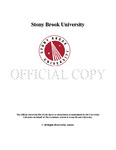| dc.identifier.uri | http://hdl.handle.net/1951/59878 | |
| dc.identifier.uri | http://hdl.handle.net/11401/71526 | |
| dc.description.sponsorship | This work is sponsored by the Stony Brook University Graduate School in compliance with the requirements for completion of degree. | en_US |
| dc.format | Monograph | |
| dc.format.medium | Electronic Resource | en_US |
| dc.language.iso | en_US | |
| dc.publisher | The Graduate School, Stony Brook University: Stony Brook, NY. | |
| dc.type | Dissertation | |
| dcterms.abstract | Structure-specific endonucleases are widespread enzymes that incise phosphodiester bonds in DNA and play key roles in DNA transactions including the maintenance of genome stability. One such enzyme is ERCC1-XPF, which cleaves single-stranded/double-stranded DNA junctions, and is involved in nucleotide excision repair (NER), interstrand crosslink (ICL) repair, homologous recombination, and other pathways. Defects in ERCC1-XPF lead to several hereditary diseases, like xeroderma pigmentosum, XFE progeroid syndrome, cranio-occulo-facio-skeletal syndrome, and Fanconi anemia. In NER, ERCC1-XPF is recruited to DNA lesions by interaction with XPA and incises the DNA 5' to the lesion. In this dissertation, the roles of the four C-terminal DNA binding domains in mediating NER activity and cleavage of model substrates were studied. It was found that mutations in the helix-hairpin-helix domain of ERCC1 and the nuclease domain of XPF abolished cleavage activity on model substrates. Interestingly, mutations in multiple DNA binding domains were required to significantly diminish NER activity, suggesting that interactions with proteins in the NER incision complex can compensate for some defects in DNA binding. These studies demonstrate that multiple domains of ERCC1-XPF contribute to substrate binding, and are consistent with the hypothesis that multiple weak protein-DNA and protein-protein interactions drive progression through the NER pathway. In addition, DNA binding residues of ERCC1-XPF were found to be more important for ICL repair than for NER. Impairment of DNA binding of ERCC1-XPF rendered cells more sensitive to exposure to crosslinking agents than to UV, suggesting tighter substrate binding by ERCC1-XPF is needed for ICL repair than for NER. Intriguingly, subsequent to our studies, mutations in DNA binding residues of XPF were found in Fanconi anemia patients, who have defects in ICL repair, showing that mutations in DNA binding domains of ERCC1-XPF can have pathway-specific pathogenic consequences in humans. | |
| dcterms.available | 2013-05-22T17:35:39Z | |
| dcterms.available | 2015-04-24T14:47:49Z | |
| dcterms.contributor | Carrico, Isaac | en_US |
| dcterms.contributor | Sch? rer, Orlando D | en_US |
| dcterms.contributor | Simmerling, Carlos | en_US |
| dcterms.contributor | Demple, Bruce. | en_US |
| dcterms.creator | Su, Yan | |
| dcterms.dateAccepted | 2013-05-22T17:35:39Z | |
| dcterms.dateAccepted | 2015-04-24T14:47:49Z | |
| dcterms.dateSubmitted | 2013-05-22T17:35:39Z | |
| dcterms.dateSubmitted | 2015-04-24T14:47:49Z | |
| dcterms.description | Department of Chemistry | en_US |
| dcterms.extent | 137 pg. | en_US |
| dcterms.format | Application/PDF | en_US |
| dcterms.format | Monograph | |
| dcterms.identifier | Su_grad.sunysb_0771E_10704 | en_US |
| dcterms.identifier | http://hdl.handle.net/1951/59878 | |
| dcterms.identifier | http://hdl.handle.net/11401/71526 | |
| dcterms.issued | 2011-12-01 | |
| dcterms.language | en_US | |
| dcterms.provenance | Made available in DSpace on 2013-05-22T17:35:39Z (GMT). No. of bitstreams: 1
Su_grad.sunysb_0771E_10704.pdf: 3263639 bytes, checksum: d9245a2821ed40315208836a868421b0 (MD5)
Previous issue date: 1 | en |
| dcterms.provenance | Made available in DSpace on 2015-04-24T14:47:49Z (GMT). No. of bitstreams: 3
Su_grad.sunysb_0771E_11231.pdf.jpg: 8178 bytes, checksum: c535dd1484c89b2d6887fd8357bd4520 (MD5)
Su_grad.sunysb_0771E_11231.pdf.txt: 206666 bytes, checksum: 96092bce68de38ab32ee780625962112 (MD5)
Su_grad.sunysb_0771E_11231.pdf: 22809134 bytes, checksum: 89fc268fb3eff6d705114e35b4a752df (MD5)
Previous issue date: 1 | en |
| dcterms.publisher | The Graduate School, Stony Brook University: Stony Brook, NY. | |
| dcterms.subject | Chemistry | |
| dcterms.title | MULTIPLE DNA BINDING DOMAINS MEDIATE THE FUNCTION OF ERCC1-XPF IN NUCLEOTIDE EXCISION REPAIR AND INTERSTRAND CROSSLINK REPAIR | |
| dcterms.type | Dissertation | |

